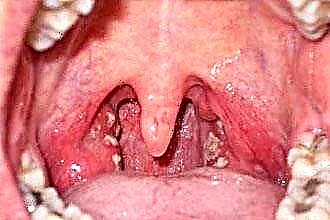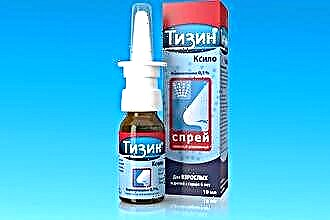Treatment for maxillary sinusitis is best started early. This makes it possible to prevent the development of dangerous symptoms and avoid surgery. Most often, real troubles begin when pus begins to accumulate in the sinuses. Therefore, in order to avoid complications, you should at least in general terms know how to treat purulent sinusitis at home.
How purulent sinusitis develops and how dangerous it is
 A purulent form of sinusitis most often develops as a consequence of the catarrhal form of the disease. In this case, the bacterial microflora joins the viral agents, which begins to actively multiply inside the accessory cavity. The following conditions can also lead to an acute form of the disease:
A purulent form of sinusitis most often develops as a consequence of the catarrhal form of the disease. In this case, the bacterial microflora joins the viral agents, which begins to actively multiply inside the accessory cavity. The following conditions can also lead to an acute form of the disease:
- the presence in the human body of a source of infection, from which bacteria can spread to the sinus;
- allergic edema, which creates a closed space in the sinus, favorable for the reproduction of pathogens;
- curvature of the nasal septum, which worsens the outflow of secretions.
A favorable environment for the development of microorganisms can be created by the following accompanying conditions:
- untimely or improper treatment of viral infections, especially seasonal ones (ARVI, ARI);
- low general immunity;
- frequent rhinitis of various etiologies (allergic, vasomotor);
- unfavorable living or working conditions (polluted or too dry air).
The presence of a focus of purulent infection near strategically important organs located in the skull and blood vessels threatens with serious complications that can affect various body systems:
- otitis media (acute otitis media);
- damage to the tissue of the eye or optic nerve with visual impairment;
- inflammation of the meninges (brain abscess, meningitis);
- urological problems (cystitis);
- deterioration of the heart muscle (myocarditis);
- damage to the osteotissue of the skull;
- bronchitis and pneumonia.
The danger of such severe complications confronts the patient with the fact that the patient must go to an otolaryngologist.
Treatment at home of a purulent sinusitis is possible only with the permission of a doctor and under his constant supervision.
How to recognize purulent sinusitis
To recognize the moment when a common runny nose or catarrhal sinusitis is complicated by a bacterial infection, you need to pay attention to the most characteristic symptoms of the disease:
- an increase in temperature to a dangerous border of 39 degrees, accompanied by fever and malaise;
- a feeling of fullness in the sinus area, when palpating, soreness is felt;
- headaches that become more intense when bending, turning, sneezing, coughing;
- redness and swelling of the cheeks and cheekbones;
- the presence of an unpleasantly smelling green snot with yellow blotches;
- alternating or bilateral nasal congestion, depending on the number of affected sinuses.
If proper treatment is not carried out, then the symptoms will increase, and the general condition of the patient will worsen. Pus is able to melt nearby tissues, and can also penetrate through the sinus wall into neighboring organs. If the infection gets into the bloodstream, it is especially dangerous.
To accurately determine the type of disease, its cause and causative agent, it is necessary to be examined in a hospital. This includes a visual examination of the nasal cavity, fluoroscopy or computed tomography, a finger test, and a nasal culture if necessary. Occasionally, a diagnostic puncture is done to take a sample of the secretion to determine the pathogen.
Treatment of purulent sinusitis with drugs
When deciding, together with a doctor, how to treat sinusitis at home quickly and efficiently, it is necessary to use various methods that can affect the disease from different directions. The main tasks that need to be solved at home are as follows:
- suppression of activity and complete destruction of pathogenic bacteria;
- ensuring the natural outflow of infected exudate from the accessory pockets;
- reduction of inflammation and the degree of swelling of the soft tissues of the sinuses and nasal cavity;
- liquefaction and regular removal of accumulated mucus from the nose by rinsing.
To achieve these goals, it is rational to use medicines and methods of traditional medicine. You can use tablets, syrups, injections, nasal drops and rinses. The main thing in this matter is no initiative, every step must be coordinated with the ENT.
 It should be noted right away that it will not be possible to cure purulent sinusitis without antibiotics. Therefore, you need to pay attention to their selection and correct reception. The doctor will prescribe antibiotics based on personal experience or culture results. These drugs can be of different types and have different mechanisms of action. The most used in practice are as follows:
It should be noted right away that it will not be possible to cure purulent sinusitis without antibiotics. Therefore, you need to pay attention to their selection and correct reception. The doctor will prescribe antibiotics based on personal experience or culture results. These drugs can be of different types and have different mechanisms of action. The most used in practice are as follows:
- cephalosporins (Cefixime, Cefalexim, Ceftriaxone);
- macrolides (Clarithromycin, Azithromycin, Macropen, Sumamed);
- penicillins (Flemoxin solutab, Ekoklav, Amoxiclav);
- fluoroquinolones (Moxifloxacin, Ciprofloxacin, Ofloxacin).
In the course of the disease of moderate severity, antibiotics are prescribed in the form of capsules and tablets, in more severe cases, intramuscular or intravenous injections are used.
If the ailment has not yet developed very much and it is possible to avoid taking strong systemic antibiotics, then the doctor may prescribe the injection or instillation of local antibiotics (Bioparox, Polydexa, Protargol, Isofra) or antiseptics (Ingalipt, Cameton) into the nasal passages.
Systemic antihistamines will help reduce swelling of the tissues in the nose. They bind free histamine in the body, which is released when exposed to allergens, and eliminate swelling, itching and rashes. Adult patients are advised to take 1 tablet of medication per day for a long period of time (up to several weeks or even months), children - half a tablet or syrup, depending on body weight and age.
It is better to use newer products with a minimum of side effects (Trexil, Zyrtec, Kestin, Lomilan, LoraGeksal). It is tedious to approach the selection of drugs for children especially carefully, you can advise Erius, Gismanal, Tsetrin. It is advisable for pregnant women to avoid taking antihistamines, especially in the first and second trimester.
Nasal drops and aerosols have a vasoconstrictor effect and reduce the volume of soft tissues in the nose. This makes it possible for some time to breathe through the nose, remove mucus and carry out the necessary manipulations. When buying drops, it is advisable to pay attention to the active ingredient, since the effect in different cases can last from 2 to 12 hours. Means such as Galazolin, Pharmazolin, Xylometazoline, Oxymetazoline, Tizin, Sanorin, Rinazolin have proven themselves well. You can alternate their reception with the instillation of Pinosol - drops based on natural essential oils that soften mucous membranes and fight microbes. However, decongestants are not used for more than 7 days, since addiction may develop.
Pains that spread over the entire head or concentrate in certain parts of the skull (temples, forehead, teeth, neck, ear) are relieved with pain pills. With a doctor's prescription, you can buy non-steroidal drugs based on acetylsalicylic acid (Amidopyrine, Aspirin), ibuprofen (Nurofen), ketoprofen (Ketanov) and paracetamol (Panadol). They not only relieve pain, but also suppress inflammatory processes.
Traditional methods of treating acute maxillary sinusitis
Traditional medicine for sinusitis is a supportive factor that enhances the action of the main drugs, and can even replace some of them. However, in the presence of pus in the accessory chambers, not all recipes of alternative medicine can be used so as not to worsen the patient's condition.
So, in the acute form of the disease, any procedures aimed at heating the sinuses are contraindicated. Therefore, no heating with sandbags or salt, a blue lamp or boiled eggs until a second X-ray confirms the complete cleansing of the sinuses from purulent accumulations. The same can be said about a number of compresses and lotions, visiting a bath or soaring feet, heat in any form can provoke an explosive multiplication of bacteria and the accumulation of a significant amount of exudate in the accessory pockets. Such a development of the situation threatens with severe pain, a breakthrough of the sinus wall and the spread of infection to neighboring organs.
The main efforts should be directed at cleansing the nose of mucus, reducing the swelling of the mucous membranes and removing purulent secretions from the sinuses. This can be done with nasal drops, turunda ointments, or rinsing.
Nasal drops are prepared from natural raw materials and help to cleanse the nose without unsafe decongestants. You can dwell on the most famous recipes:
 Black radish. Freshly squeezed juice of this root vegetable, mixed with bee honey and aloe juice (proportion 2: 1: 1), is instilled into the nose so that the liquid enters the fistula. Enough 2 drops twice a day. You can also drip radish juice diluted with water or in pure form. Despite some inconveniences (slight burning and sneezing), the epithelium is disinfected, the drainage of the chamber is improved and the mucus liquefies.
Black radish. Freshly squeezed juice of this root vegetable, mixed with bee honey and aloe juice (proportion 2: 1: 1), is instilled into the nose so that the liquid enters the fistula. Enough 2 drops twice a day. You can also drip radish juice diluted with water or in pure form. Despite some inconveniences (slight burning and sneezing), the epithelium is disinfected, the drainage of the chamber is improved and the mucus liquefies.- Beet. Its juice is used alone or in combination with honey and carrot juice. It is necessary to carefully strain the liquid and dilute it with saline or boiled water. After instillation, the amount of mucus excreted increases markedly.
- Cyclamen. To prepare the drops, the root of the plant is finely grated, the resulting gruel is squeezed out, and the resulting juice is diluted with water in proportions of 1: 8 or 1: 4. 3 drops are poured into each nostril, after which sneezing and exudate discharge begins. You need to be very careful with cyclamen juice, as undiluted it is a strong poison.
- Pouring 3 drops of Kalanchoe juice into the nostrils has a similar effect. A lot of mucus is evacuated as a result of uncontrolled sneezing, lasting up to 15 minutes.
Improvement in the outflow of exudate can be achieved by using modern homeopathic medicines such as Cinnabsin or Sinupret. They are relatively safe and come in pill or drop form.
Home rinsing
Washing is a necessary procedure for purulent sinusitis. Without them, effectively cleaning the nasal cavity and air pockets will not work. You can rinse your nose both with the help of pharmaceutical preparations and with homemade solutions. Let's consider the most effective and inexpensive ones:
- Saline solution. It gently affects the mucous membranes, softens the crusts and liquefies the thick secretion accumulated in the nasal cavity. Saline is bought at a pharmacy, but more often it is prepared independently from a glass of boiled water and 2-3 g of table salt. You can enhance its disinfecting effect with several crystals of potassium permanganate (to a light pink color) or two drops of iodine.
- Decoctions of herbs. The standard recipe is a tablespoon of herbs in one glass of boiling water, infused for half an hour. Rinse at least 3 times a day. Sage, chamomile, celandine, St. John's wort and other herbs are used.
- Furacilin. 1 tablet is diluted in 200 ml of warm water. The yellow liquid has the property of killing microbes, but is contraindicated in people who have kidney problems.
- Propolis. 20 drops of 10% propolis tincture on alcohol is poured into a glass of saline solution. In addition to removing mucus, it has a mild analgesic effect.
If there is no time to prepare rinsing solutions, then you can buy ready-made irrigation products at the pharmacy, such as Malavit, Elekasol or Rotokan.

 Black radish. Freshly squeezed juice of this root vegetable, mixed with bee honey and aloe juice (proportion 2: 1: 1), is instilled into the nose so that the liquid enters the fistula. Enough 2 drops twice a day. You can also drip radish juice diluted with water or in pure form. Despite some inconveniences (slight burning and sneezing), the epithelium is disinfected, the drainage of the chamber is improved and the mucus liquefies.
Black radish. Freshly squeezed juice of this root vegetable, mixed with bee honey and aloe juice (proportion 2: 1: 1), is instilled into the nose so that the liquid enters the fistula. Enough 2 drops twice a day. You can also drip radish juice diluted with water or in pure form. Despite some inconveniences (slight burning and sneezing), the epithelium is disinfected, the drainage of the chamber is improved and the mucus liquefies.

